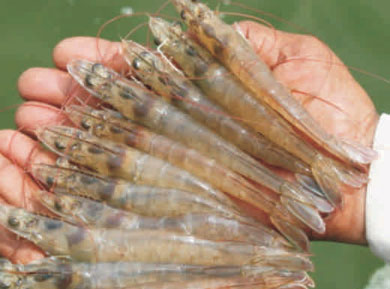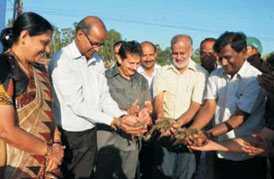
-
Pacific white shrimp, Letopenarus vannamei is one of the new candidate species introduced in Indian coastal aquaculture. Since its commercial introduction in the year 2009, the farming of this exotic species has gained tremendous momentum in India owing to its faster growth rate, tolerance to high stocking density, lower dietary protein requirement and tolerance to wide ranges of salinity and temperature. Following its tremendous success in coastal states, successful attempts were made by CIFE, Mumbai at its Regional Centre, Rohtak to develop practices for profitable aquaculture of L. vannamei in inland saline waters.
Description of technologyThe major challenges encountered for L. vannamei culture were the quality of ground saline water because of its ionic imbalance. Inland saline waters invariably have low levels of potassium, high levels of calcium and variable concentrations of magnesium in comparison to natural sea water. The cultivation of L. vannamei was undertaken in 3 ponds having a total area of 0.60 ha using inland saline water with a salinity range of 13-15 ppt. The ponds were prepared for culture following the standard ways of pond preparation for shrimp culture. As the saline affected soils have high pH (8.0-9.0) no lime was applied.
The pond water was fortified with commercial grade fertilizer, muriate of potash to maintain optimum levels of potassium (about 50 % of the equivalent salinity of potassium concentration in sea water) as the water source was deficient in potassium. The ponds were fertilized with fermented organic slurry prepared with molasses, rice bran, oil cake and yeast to develop natural food organisms in the pond water. After 5 days of fertilization, the ponds were stocked with L. vannamei SPF post-larvae procured from Bay Fry Hatchery, Kakinada, Andhra Pradesh. The post larvae were stocked at the rate of 55 3 nos./m . Commercial shrimp feed (CP Aquaculture India Pvt. Ltd and Avanti Feeds Pvt. Ltd.) was used ad-libitum for feeding the animals. For the initial 40 days, the feeding schedule was prepared based on the hapa survival obtained after 96 hours of stocking. For the rest of the culture period, the feeding ration was prepared following the estimated shrimp biomass obtained from the weekly sampling. The water quality parameters like salinity, pH, dissolved oxygen, hardness, calcium, magnesium, alkalinity and potassium were regularly monitored and recorded in the range of 13- 15 ppt, 7.8-9.0, 5.4-8.2 ppm, 3200-3700 ppm, 250-320 ppm, 600-670 ppm, 200-230 ppm and 80-100 ppm respectively. An adequate number of maintaining desired level of dissolved oxygen in the pond water. At certain occasions, soil and water probiotics were used for the maintenance of the desired water quality and upkeep of pond bottom health. A total production of 13.4 tons/ha/120 days. The results of the present study proved that inland saline waters can be profitably utilized for L. vannamei culture by execution of cost effective ionic amendments. Technology benefits
Technology benefitsInterception of ground saline water and utilization in aquaculture ponds will lower the ground table, help in soil improvement and reduction of secondary salinization. Since inland saline water is drawn from bore wells at different depths, it is free from pathogens and biosecure, unlike coastal areas. As the vast stretch of agriculture land became saline and unfit for any agricultural activity, the farmers can undertake L. vannamei culture for 100‐120 days like any other agriculture crop and reap an enormous profit. Target geographical areas Around 8.62 million hectares of agricultural land has been badly affected with the problem of soil salinity and 1.93 million square kilometres area is under laden with ground saline water in India. Of the total inland saline area about 40% is contributed by Haryana, Uttar Pradesh, Punjab and Rajasthan and at the same time 41-84% of ground water is un-potable in these states. The L. vannamei culture technology has enormous scope to implement in these areas.
